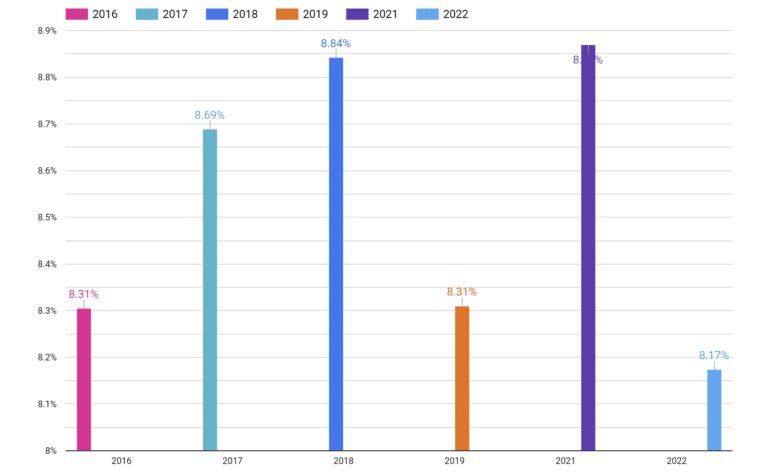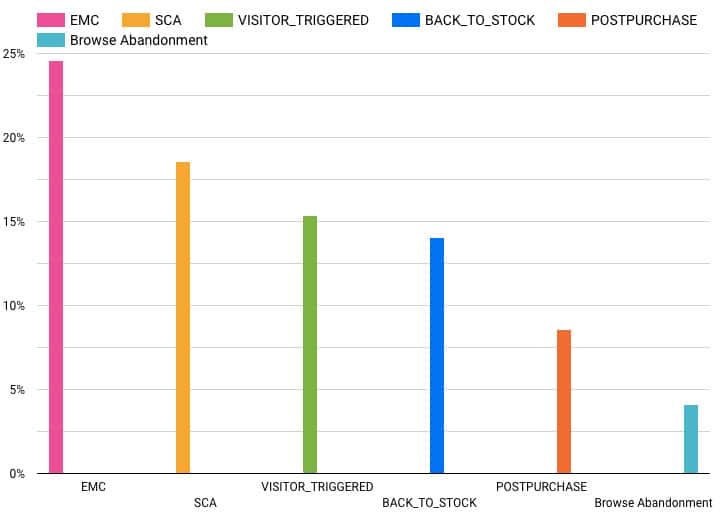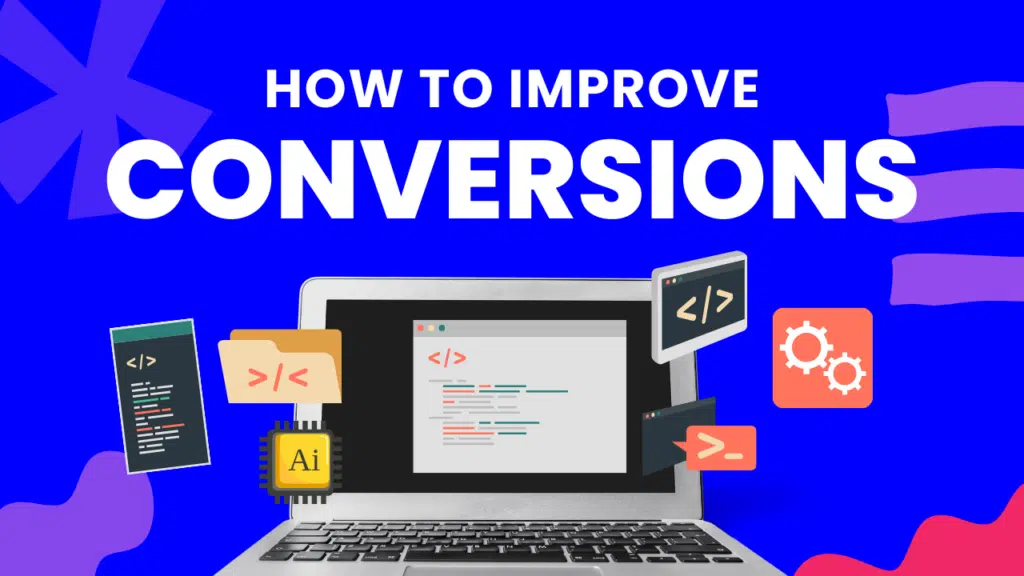Email marketing isn’t just alive in 2025, it’s still one of the highest-ROI channels in digital marketing. But it’s not enough to send emails. You need them to convert. That’s why optimizing your email conversion rate is non-negotiable.
The reason is that it’s a powerful tool for both SaaS and ecommerce businesses and organizations of all sizes to connect with their audience directly, deliver tailored messages, and drive action.
However, the success of email campaigns isn’t solely about crafting compelling content and eye-catching designs; it’s also about measuring the outcomes.
This is where the email conversion rate comes into play.
In this article, I’ll define the terminology, highlight how email conversion rate helps businesses, outline the formula and show calculations, and give you tips to improve your email conversion rate.
Let’s get started.
What Is Email Conversion?
Email conversion refers to the pivotal moment when your email or newsletter successfully persuades your subscribers or recipients to take a desired action.
This action can vary widely depending on your campaign’s objective but typically includes activities like making a purchase, signing up for a webinar, filling out a contact form, or downloading a resource.
The essence of email conversion lies in its ability to turn passive readers into engaged participants. It’s about moving your audience from the stage of mere observation to active involvement, ultimately contributing to your business’s goals.
Your email content should be compelling, relevant, and targeted to your audience’s needs and interests to achieve email conversion. You want to pique their curiosity, provide valuable information, and build trust while guiding them towards that specific action you want them to take.
What Is the Email Conversion Rate?
Email conversion rate is a vital metric that measures the success of your email campaigns.
It is defined as the ratio of the number of recipients who perform the desired action (such as making a purchase, signing up for a webinar, or subscribing to a newsletter) to the total number of emails sent in a specific campaign.
This rate is typically expressed as a percentage, providing valuable insights into the effectiveness of your email marketing efforts.
How Email Conversion Rate Helps Businesses
1. Performance Evaluation:
Email conversion rate acts as a barometer of your campaign’s performance. A higher conversion rate indicates that your emails are resonating with your audience and compelling them to take the desired actions. Conversely, a lower rate may signal the need for improvement in your email content, design, or targeting.
2. Segmentation and Targeting:
By analyzing conversion rates for different segments of your email list, you can gain insights into which subscriber groups are responding well to your campaigns and which are not. This helps you tailor your messages and offers to specific audience segments, increasing the chances of conversion.
3. Content Optimization:
Email conversion rate can reveal the effectiveness of your email content and calls to action. If you notice a low conversion rate, it may be an indicator that your content needs to be more persuasive, informative, or engaging. You can experiment with different content formats, subject lines, and visuals to see what resonates best with your audience.
4. A/B Testing:
Businesses can conduct A/B tests by sending two versions of an email to a subset of their subscribers and measuring which one generates a higher conversion rate. This data-driven approach helps you identify what elements of your emails are working and what needs refinement.
5. ROI Assessment:
Understanding your email conversion rate allows you to calculate your email marketing campaigns’ return on investment (ROI). You can measure the revenue generated from conversions against the costs associated with email marketing to determine the overall profitability of your efforts.
How To Calculate Email Conversion Rate
Calculating conversion rate for an email can be done using the following formula:

Email Conversion Rate (%) = (Number of Conversions / Number of Delivered Emails) x 100
Now, let’s break down this formula with an example:
Example:
Suppose you run an email marketing campaign for your online store. You send out 5,000 emails promoting a special offer, and out of those, 400 recipients click on the offer link and make a purchase. To calculate the email conversion rate for this campaign:
- Number of Conversions (Purchases): 400
- Number of Delivered Emails: 5,000
Using the formula:
Email Conversion Rate (%) = (400 / 5,000) x 100 = 8%
So, in this example, the email conversion rate for your campaign is 8%. This means that 8% of the recipients who received your email took the desired action (made a purchase), indicating the effectiveness of your campaign in converting email recipients into customers.
5 Reasons That Can Cause A Low Email Conversion Rate
1. iOS Updates:
iOS updates, particularly changes in email client behavior, can have a significant impact on your email conversion rate.
When Apple updates its operating system, it often introduces changes to the way emails are displayed and processed. For instance, new privacy features may limit email tracking and data collection, making it harder to personalize content or track conversions accurately.
Additionally, changes to the default email app can affect how emails render and function. If your emails are not optimized for these updates, they may appear broken or not display properly, leading to a poor user experience.
To mitigate this, it’s crucial to stay informed about iOS updates and make necessary adjustments to your email templates and tracking methods to ensure they remain effective.
2. Poor Deliverability = Landing More in the Spam Folder:
Emails that land in the spam folder face a significant challenge in achieving conversions.
When your emails are marked as spam by email service providers or recipients, they may never be seen or opened, let alone result in conversions. Several factors can contribute to poor deliverability:
- Sender Reputation: If your sender reputation is tarnished due to previous spam complaints or low engagement rates, your emails are more likely to be flagged as spam. Maintaining a good sender reputation is crucial for inbox placement.
- Misleading Subject Lines or Content: Emails with misleading subject lines or content that appears spammy are more likely to trigger spam filters. Ensure your subject lines accurately reflect the email’s content, and avoid excessive use of spammy keywords.
- List Hygiene: Sending emails to outdated or unengaged email addresses can negatively impact deliverability. Regularly clean your email list to remove inactive or invalid addresses.
- Authentication and Encryption: Implement authentication protocols like SPF, DKIM, and DMARC to verify your domain’s authenticity, reducing the chances of spoofing or phishing.
3. Emails Not Optimized for Mobile:
With the increasing use of smartphones, many people check their emails on mobile devices.
If your emails are not optimized for mobile viewing, they may appear distorted or be challenging to read, leading to a poor user experience and reduced conversion rates.
To optimize for mobile:
- Use responsive design techniques to ensure emails adapt to different screen sizes.
- Keep subject lines and preheader text concise to fit mobile screens.
- Use large, easy-to-tap buttons and links.
- Test your emails on various mobile devices and email clients to ensure compatibility.
4. Low Open Rates:
Low email open rates can directly impact your email conversion rate because if recipients don’t open your emails, they can’t take the desired action. Several factors can contribute to low open rates:
- Unengaging Subject Lines: Subject lines play a crucial role in enticing recipients to open your emails. Craft compelling and relevant subject lines to increase open rates.
- Sending Frequency: Overwhelming your email subscribers with too many emails can lead to fatigue and lower open rates. Find the right balance for your audience.
- Email List Quality: A disengaged or unsegmented email list can result in lower open rates. Segment your list and send targeted content to increase relevance.
5. Poor Design/Formatting:
The design and formatting of your emails can significantly impact their effectiveness.
A poorly designed email with cluttered content, inconsistent branding, or broken elements can deter recipients from taking action.
To improve design and formatting:
- Use a clean and visually appealing layout.
- Ensure images and text display correctly on all email clients.
- Use clear and compelling calls to action (CTAs) that stand out.
- Test your emails on various devices and email clients to ensure they look polished and professional.
Addressing these five factors can help you identify and rectify issues that may be causing a low email conversion rate, ultimately improving the effectiveness of your email marketing campaigns.
What Is A Good Email Conversion Rate?
The truth is, it depends. Determining what constitutes a good email conversion rate is not a one-size-fits-all endeavor.
Email conversion rates can vary widely across industries, businesses, and even specific campaigns. What may be considered a remarkable conversion rate for one company might be underwhelming for another.
The ideal email conversion rate depends on several factors, and understanding these factors is crucial for setting realistic benchmarks and expectations.
Factors Affecting Email Conversion Rates:
1. Industry:
Different industries have different average conversion rates. For example, e-commerce businesses might have lower conversion rates compared to B2B service providers. Understanding the benchmarks within your specific industry can provide context for evaluating your performance.
2. Audience:
Your target audience’s behavior and preferences play a significant role. A highly engaged and loyal audience is more likely to yield higher conversion rates than a disengaged one.
3. Campaign Objectives:
The purpose of your email campaign matters. If your goal is to drive immediate sales, your conversion rate expectations may differ from a campaign focused on lead generation or brand awareness.
4. Email List Quality:
The health and segmentation of your email list can impact conversion rates. A clean, well-maintained list with engaged subscribers is more likely to yield higher conversions.
5. Design and Mobile Optimization:
The design and mobile-friendliness of your emails influence user experience. Aesthetically pleasing and mobile-responsive emails tend to convert better.
Average Conversion Rate For Emails.
Average conversion rates over time

The first thing we notice is that email remains an incredibly effective channel for driving purchases.
The average conversion rate peaked in 2021 at 8.87%. However, 2022 saw the lowest total conversion rate at 8.17%.
Still, converting this many customers is a huge advantage for retailers who are able to effectively engage their customer base again and again.
Average email conversion rates by campaign type

The lowest converting campaign type is browse abandonment. These emails convert at a 4.10%.
However, when you consider the nature of these emails, it is a significant improvement over not having any type of engagement at all.
Once customers demonstrate higher purchase intent, emails convert at a substantially higher rate.
The most effective triggered email type by conversion rate is “Email My Cart”. It triggers after a customer has added an item to their cart and then attempts to abandon the session.
8 Tips to Boost and Increase Email Conversion Rates
1. Segment Your Email List:
You’ll expect this to be common knowledge, but many email list owners/ businesses don’t segment their list.
Segmentation involves dividing your email list into smaller, more targeted groups based on specific criteria, such as demographics, customer behavior, or purchase history.
This allows you to send highly relevant content to each segment, which can significantly boost conversion rates.
Here’s how you can implement this:
- Start by collecting relevant data from subscribers, such as preferences, purchase history, and geographic location.
- Use an email marketing platform that supports list segmentation.
- Create segments based on meaningful criteria and regularly update and refine them as you gather more data.
2. Personalize Your Emails:
Personalization goes beyond simply addressing the recipient by name (tho this can work too)
It involves crafting email content that speaks directly to the recipient’s interests, preferences, and past interactions with your brand.
Utilize data such as purchase history, browsing behavior, and demographic information to create personalized product recommendations or tailored offers.
Personalized emails create a sense of individualized attention, which can significantly increase conversion rates.
Here’s how you can implement this:
- Utilize dynamic content blocks that change based on the recipient’s behavior or profile.
- Recommend products or services based on past interactions or preferences.
- Craft personalized email subject lines and email copy that directly address the recipient’s needs or interests.
3. Craft Compelling Subject Lines:
The subject line is your email’s first impression and plays a crucial role in whether it gets opened or ignored.
Create subject lines that pique curiosity, offer value, or evoke emotions. Use A/B testing to experiment with different subject line strategies, such as urgency, curiosity, or personalization, to determine what resonates best with your audience.
Here’s how to do this:
- Keep subject lines concise and to the point, typically under 50 characters.
- Use emojis sparingly to add visual appeal and context to subject lines.
- Experiment with urgency, curiosity, and value-driven subject lines to see what resonates best with your audience.
4. Optimize Email Design for Mobile:
With a growing number of people checking emails on mobile devices, it’s vital that your emails are mobile-responsive.
Ensure your emails display correctly and are easy to read on smartphones and tablets. Use a single-column layout, large fonts, and touch-friendly buttons to enhance the mobile user experience.
Here’s how you can implement this:
- Test your emails on different mobile devices and email clients to ensure compatibility.
- Ensure all text is easily readable without zooming, and use single-column layouts and larger fonts for improved mobile usability.
5. Clear and Compelling CTAs:
Your email should have a clear and enticing call-to-action button. Use action-oriented language, such as “Shop Now,” “Get Started,” or “Download Now.”
Make sure your CTA buttons stand out with contrasting colors and consider their placement within the email for maximum visibility. The CTA should align with the email’s purpose and guide recipients toward the desired action.
Note: Place your primary CTA prominently within the email, ideally above the fold.
6. A/B Testing:
A/B testing (or split testing) involves sending two variations of an email to a subset of your audience to determine which one performs better.
Test different elements like subject lines, email content, CTAs, and images to identify what resonates with your audience. Continuously refine your emails based on A/B testing results to improve conversion rates over time.
- Begin with A/B testing of one variable at a time to isolate the impact of changes.
- Use statistically significant sample sizes to draw accurate conclusions.
- Analyze and Refine: Continuously monitor and analyze results to refine your email marketing strategy.
- Test not only email content but also sending times, subject lines, and sender names.
7. Social Proof:
Incorporate social proof into your emails to build trust and credibility.
Highlight customer reviews, testimonials, ratings, or user-generated content that showcases positive experiences with your products or services.
Social proof reassures recipients that others have had a positive outcome, making them more likely to convert.
Here are the steps you can take:
- Incorporate customer reviews and testimonials into email content.
- Showcase User-Generated Content such as photos or videos, from satisfied customers.
- Include trust badges, certifications, or awards received by your business.
- Use social proof strategically, matching it to the recipient’s stage in the customer journey.
8. Email List Cleanup:
Periodically review your email list for inactive or invalid email addresses.
A clean list improves deliverability and ensures your emails reach engaged recipients.
Here’s what you can do to achieve a clean list:
- Regularly review your email list for inactive or invalid email addresses.
- Send re-engagement email campaigns to win back disengaged subscribers.
- Respect unsubscribe requests promptly to maintain trust and compliance.
- Implement double opt-in procedures for new subscribers to ensure list quality.
Final Thoughts
Email conversion rates are a pivotal measure of email marketing success. They provide insights into campaign performance, audience targeting, and content optimization.
Various factors, such as iOS updates, deliverability issues, mobile optimization, low open rates, and email design, can influence these rates. While there is no universal benchmark for a “good” conversion rate, it varies by industry and specific goals.
Consider implementing strategies like list segmentation, personalized content, compelling subject lines, mobile optimization, clear CTAs, A/B testing, social proof integration, and maintaining a clean email list to enhance your email conversion rates.
Mastering the art of email conversion rate is essential for achieving effective email marketing outcomes.
Conversion Rates Email Marketing FAQs
What is a good conversion rate on email marketing?
A good email conversion rate typically ranges from 1% to 5%, depending on the industry and offer quality.
What is a good CTR for email marketing?
A strong email click-through rate (CTR) is around 2% to 5%, though this varies by list quality and email relevance.
What is the conversion rate for direct email?
Direct email campaigns average a conversion rate of 1% to 5%, with higher rates for segmented and personalized sends.
What is a good ROI for email marketing?
Email marketing delivers an average ROI of $36–$40 for every $1 spent, making it one of the top-performing channels.
What is a conversion email?
A conversion email is designed to get recipients to take a specific action, like making a purchase, booking a demo, or signing up.
What is the formula for CTR rate in email?
CTR = (Clicks ÷ Total Emails Delivered) × 100



